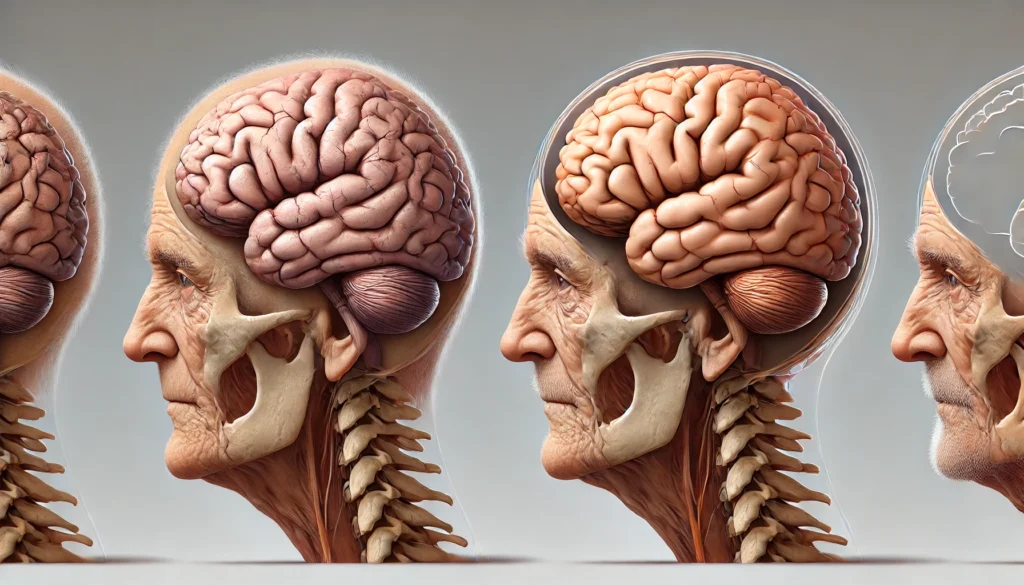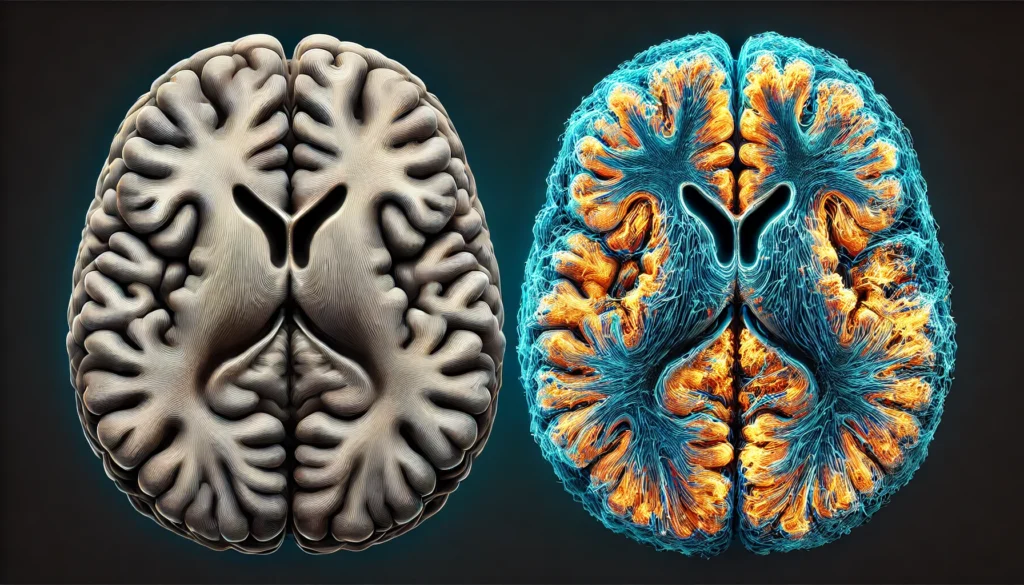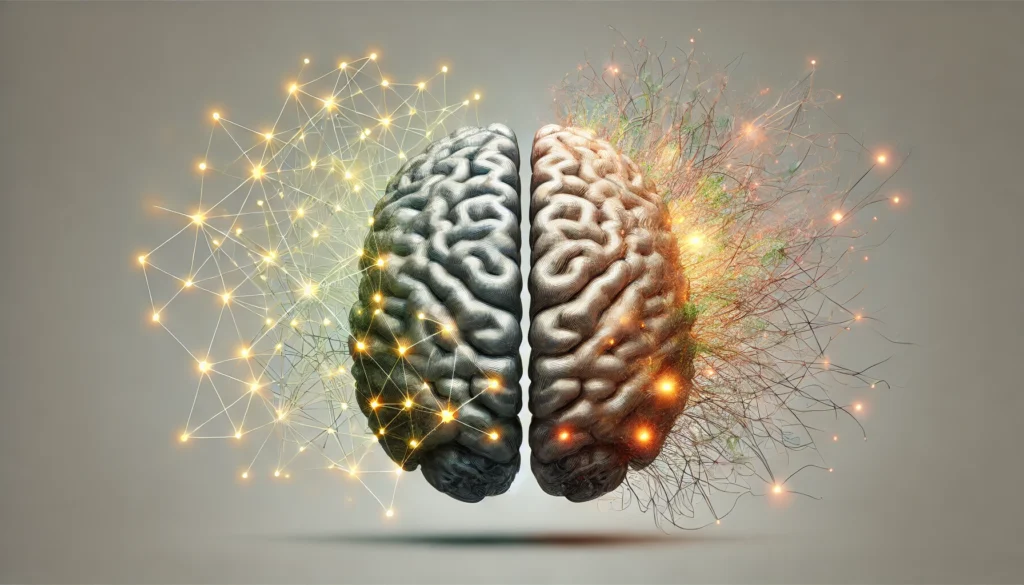This article delves deep into the variances between a healthy brain and one affected by dementia, unraveling the scientific intricacies and providing insights into the implications of these changes.
You may also like: Tips to Improve Low Average Memory Performance
What Does a Normal Brain Look Like?
A healthy brain is a marvel of biological engineering, maintaining a delicate balance of chemical and electrical signals. It is responsible for processing the sensory information that allows us to interact with and comprehend the world around us. The cerebral cortex, a key component of the brain, is responsible for higher-level functions such as decision-making, language, and perception. As we age, the brain experiences natural wear and tear; however, its capacity for neuroplasticity often compensates for these changes, allowing us to learn and adapt.
The Anatomy of a Healthy Brain
The brain’s structure is complex and highly organized. The cerebral cortex is divided into two hemispheres and further into lobes that specialize in different functions. The frontal lobe, for instance, governs decision-making and personality, while the occipital lobe handles visual processing. Each part works in harmony to keep us functioning smoothly.
Neuroplasticity: The Brain’s Remarkable Adaptability
Neuroplasticity refers to the brain’s ability to reorganize itself by forming new neural connections. This ability allows the brain to adapt to changes, learn from new experiences, and recover from injuries. Even as we age, neuroplasticity plays a crucial role in maintaining cognitive functions. This adaptability is a testament to the brain’s resilience and its capacity to combat the effects of aging.
Normal Forgetfulness vs. Dementia
It’s important to distinguish between normal forgetfulness and dementia. Forgetting where you placed your keys occasionally or the name of an acquaintance is common and generally not a cause for concern. This is a part of the natural aging process and is not indicative of dementia. In contrast, dementia involves a more significant decline in memory and cognitive abilities that disrupts daily life.
What Does a Brain with Dementia Look Like?
Dementia is not a single disease but a collective term for a range of symptoms that involve a decline in memory, thinking, and social abilities severe enough to interfere with daily life. The most common form of dementia is Alzheimer’s disease, but there are other types, including vascular dementia, Lewy body dementia, and frontotemporal disorders. Each type has distinct characteristics and affects the brain differently.
The Biological Changes in Dementia
In dementia, the brain undergoes various pathological changes. In Alzheimer’s disease, for instance, the brain develops plaques made of beta-amyloid and tangles of tau protein, which disrupt neuronal communication. These changes lead to the death of brain cells and a noticeable decrease in brain size over time. Understanding these biological alterations is crucial for developing targeted treatments and interventions.
Areas of the Brain Affected by Dementia
The progression of dementia affects various parts of the brain differently:
- Hippocampus: This area is crucial for forming new memories. In Alzheimer’s disease, the hippocampus is often one of the first regions to suffer damage, leading to memory loss. As dementia progresses, the ability to create and retain new memories diminishes, impacting daily life significantly.
- Cerebral Cortex: Responsible for higher brain functions, the cortex’s shrinkage can result in impaired judgment, language difficulties, and disorientation. This shrinkage affects the ability to perform complex tasks, solve problems, and communicate effectively.
- Frontal and Temporal Lobes: Damage here affects personality, behavior, and the ability to plan and organize. Changes in these areas can lead to impulsive behavior, mood swings, and difficulties in social interactions.
More Than Natural Aging
While some cognitive decline is a natural part of aging, dementia represents a significant departure from normal aging. It is a result of complex changes in the brain, including the buildup of plaques and tangles in Alzheimer’s or the loss of nerve cells and connections. These changes are not inevitable and represent a distinct pathological process that requires medical attention.

Is Alzheimer’s Disease a Normal Part of Aging?
A common misconception is that Alzheimer’s and dementia are inevitable with aging. However, dementia is not a normal part of aging. While age is a significant risk factor, not everyone will develop Alzheimer’s or another form of dementia. Understanding this distinction is vital for recognizing when to seek medical advice.
The Risk Factors Beyond Age
Several factors contribute to the risk of developing dementia, including genetics, lifestyle, and environmental influences. While age is a predominant risk factor, managing other elements like cardiovascular health, diet, and mental activity can mitigate risks. Identifying these factors can help in creating personalized prevention strategies.
Not Just Normal Aging
Understanding that dementia is not just an extension of normal aging is vital. It is a disease with distinct pathological features that differentiate it from the usual age-related changes in the brain. Recognizing these differences can lead to earlier diagnosis and better management of the condition, improving the quality of life for those affected.
The Importance of Early Diagnosis
Early diagnosis of dementia can lead to more effective management and treatment. Identifying the condition in its initial stages allows for interventions that can slow progression, optimize daily functioning, and provide better support for patients and caregivers. Awareness and education about the early signs of dementia are essential for timely diagnosis.
Historical Context and Current Trends
Historically, dementia was often misunderstood and stigmatized. However, advances in neuroscience have illuminated the biological underpinnings of these diseases. The current trend emphasizes early diagnosis and intervention, aiming to slow progression and improve quality of life.
Shifting Perceptions of Dementia
In the past, dementia was often seen as an inevitable part of aging, leading to stigma and a lack of understanding. Today, increased awareness and education have shifted perceptions, recognizing dementia as a medical condition that requires attention and care. This shift has fostered greater empathy and support for those affected.
Advances in Research and Technology
Technological advancements have propelled dementia research forward, allowing for better imaging techniques and diagnostic tools. These innovations enable scientists to study the brain in greater detail, uncovering insights that contribute to the development of new treatments. Continued investment in research is crucial for achieving breakthroughs in dementia care.
Future Implications
The future of dementia research holds promise with potential breakthroughs in treatment and prevention. As we continue to unravel the genetic and environmental factors contributing to these conditions, the hope is to develop strategies that can delay or even prevent the onset of dementia. Collaborative efforts in research and global initiatives are paving the way for a future where dementia can be more effectively managed.

Practical Advice for Maintaining Brain Health
While genetics play a role in dementia risk, lifestyle factors are crucial in maintaining brain health. Here are some practical tips:
Regular Exercise
Physical activity increases blood flow to the brain and can encourage the growth of new brain cells. Engaging in regular exercise, such as walking, swimming, or yoga, can help maintain cognitive functions and reduce the risk of cognitive decline. Exercise also promotes overall well-being, contributing to a healthier brain.
Balanced Diet
A diet rich in fruits, vegetables, whole grains, and lean proteins supports brain health. Consuming foods high in antioxidants and omega-3 fatty acids can protect brain cells from damage. Maintaining a balanced diet is a proactive step towards preserving cognitive abilities and preventing the onset of dementia-related symptoms.
Mental Stimulation
Engaging in mentally stimulating activities can help maintain cognitive functions. Activities like reading, puzzles, and learning new skills challenge the brain and promote neuroplasticity. Keeping the mind active is a vital aspect of maintaining brain health and can delay the progression of cognitive decline.
Social Engagement
Maintaining strong social connections can protect against cognitive decline. Interacting with friends, family, and community members provides mental stimulation and emotional support. Social engagement encourages a sense of belonging and purpose, which are important for mental well-being.
Quality Sleep
Ensuring adequate rest can help clear toxins from the brain that accumulate during the day. Quality sleep is essential for cognitive processes, memory consolidation, and overall brain health. Establishing a regular sleep routine and creating a restful environment can enhance sleep quality and contribute to better cognitive functioning.

Conclusion
Understanding the differences between a normal brain and one affected by dementia is essential for recognizing the symptoms and seeking appropriate care. While aging is inevitable, dementia is not, and through a combination of lifestyle adjustments and medical interventions, we can strive to maintain cognitive health well into our later years.
By staying informed and proactive, we can better support those affected by dementia and work towards a future where these conditions can be effectively managed or even prevented. Ongoing research, coupled with public awareness and education, is key to achieving this goal and improving the lives of individuals and families impacted by dementia.
Further Reading:
Alzheimer’s brain vs. normal brain: What to know
Important Note: The information contained in this article is for general informational purposes only, and should not be construed as health or medical advice, nor is it intended to diagnose, prevent, treat, or cure any disease or health condition. Before embarking on any diet, fitness regimen, or program of nutritional supplementation, it is advisable to consult your healthcare professional in order to determine its safety and probable efficacy in terms of your individual state of health.
Regarding Nutritional Supplements Or Other Non-Prescription Health Products: If any nutritional supplements or other non-prescription health products are mentioned in the foregoing article, any claims or statements made about them have not been evaluated by the U.S. Food and Drug Administration, and such nutritional supplements or other health products are not intended to diagnose, treat, cure, or prevent any disease.


